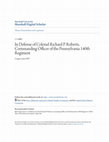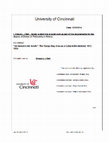Papers by Gregory Jason Bell
Ohio Valley History, 2009
In November 1914, Britain went to war against the Ottoman Empire. Shortly thereafter, the British... more In November 1914, Britain went to war against the Ottoman Empire. Shortly thereafter, the British Navy attacked Turkish forts in the Dardanelles with the objectives of forcing the Straits,attacking and conquering Constantinople and knocking Turkey out of the war early. The monthlong purely naval attack, however, proved unsuccessful, as the British Navy was never able to silence the forts and force the Straits. Instead, the British aborted their purely naval campaign, opting instead for a land invasion of the Gallipoli peninsula that also failed. This paper documents the multiple strategic, operational and tactical errors made by the British during their naval Dardanelles campaign, concluding that tactical errors loomed large in the campaign’s failure.
This article begins by documenting the main reasons the Spanish failed to establish a self-sustai... more This article begins by documenting the main reasons the Spanish failed to establish a self-sustaining colony in Florida during the First Spanish Period, 1513–1763. It then documents the steps Great Britain took during its short-lived possession of Florida (1763–1783) to occupy, govern and repopulate the territory with the ultimate goal of transforming it from an unproductive Spanish backwater into a civilized and profitable British colony, centered on the plantation system and black chattel slavery. Ultimately, this article contends, contrary to what some historians have argued, that the British, despite the brevity of their rule, greatly influenced the social, political and economic development of Florida.
After the U.S. Civil War, plentiful and varied natural resources, combined with a sizeable, multi... more After the U.S. Civil War, plentiful and varied natural resources, combined with a sizeable, multicultural population influx, led to the increased development of the lumber, fishing, citrus and cattle industries in the Tampa Bay area, on the Gulf coast of Florida. These industries all had the Cuban market in common, but different segments of society concentrated on different industries, with varying outcomes. White native Tampans, with a few notable exceptions, made the fewest
economic gains during the era, which to some degree leveled the playing field going into the Gilded Age, thereby making the Tampa Bay area relatively unique within the former Confederacy.

Ignoring borders, which are constructs, nineteenth-century Tampa was not Southern. Instead, it wa... more Ignoring borders, which are constructs, nineteenth-century Tampa was not Southern. Instead, it was home to a polyglot society that survived frontier conditions through cooperation. In the last decade of the century, however, and especially after the Spanish-American War of 1898, Tampa’s multicultural coalition gave way to New South pressures. Although whites remained a minority, they had by then acquired the socioeconomic resources to take political control of what was quickly becoming a New South city. In an effort to “sanitize” local history and celebrate their own superiority while appeasing the non-white majority, Tampa’s white civic elite devised and actuated the Gasparilla Parade, which is still held annually. Most modern-day parade spectators
and participants, however, remain ignorant of the parade’s original purposes, a testament to the organizers’ successful revision of local history.

Richard P. Roberts was the colonel of the Pennsylvania 140th regiment
from its organization in Se... more Richard P. Roberts was the colonel of the Pennsylvania 140th regiment
from its organization in September 1862 until his death at Gettysburg in July
1863. During this time period, Captain David Acheson of Company C fostered a
“growing dislike” for the colonel that led him to portray the colonel negatively in
his writings. Unfortunately for the colonel’s reputation, Acheson’s letters have
been widely published, leading at least one historian to accept Acheson’s poor
opinion of the colonel as fact. However, other primary sources exist which
collectively demonstrate a positive regimental opinion of the colonel and further
suggest that Acheson’s criticisms of the colonel were largely unwarranted and
were a product of his own biases instead of an honest appraisal of the colonel’s
performance. In fact, Colonel Roberts performed his duties admirably and is
worthy of a commendation that, until now, the Acheson letters have largely
denied him.
Books by Gregory Jason Bell

Although physically part of North America, peninsular Florida extends southward into the Caribbea... more Although physically part of North America, peninsular Florida extends southward into the Caribbean. This geographic proximity resulted in a reciprocal relationship with Cuba that long transcended geopolitical borders. Much of the peninsula was also socioeconomically tied to the continent, but the Tampa Bay area was not. Rather, a number of variables delayed its Americanization and southernization until the beginning of the twentieth century.
Initially, the Tampa Bay area was a Caribbean periphery. Its original inhabitants came from the Caribbean and maintained a maritime lifestyle. After the Columbian Exchange and subsequent warfare led to their extinction, southeastern Amerindians moved in and made adaptive shifts, including establishing strong relationships with Hispanics in Cuba and at fishing ranchos along the Gulf coast. Although both the Spanish and the British intruded in local affairs, they were unable to break these ties. With the formation of the United States, the Tampa Bay area soon became a borderland caught between competing cultural hearths—American and Caribbean.
White Americans grew increasingly frustrated over Florida’s status as a refuge for fugitive slaves, who established a community in the Tampa Bay area and began trading with Cuba. Florida’s Amerindians, then known collectively as Seminoles, began harboring these fugitives and incorporating them into their society. In response, the United States took possession of Florida in 1821 and removed the Seminoles from all but the southernmost peninsula. Hispanics, allowed to remain in the Tampa Bay area, maintained and even strengthened its Caribbean connection. White rural Crackers largely filled the void left by the Seminoles, selling cattle to the Cuban market. Southern planters also moved to the area but achieved little economic success. As a result, slavery failed to establish an adequate foothold, and the Bay area remained a diverse cultural frontier for the remainder of the antebellum period.
The Civil War and the subsequent Union naval blockade of Florida temporarily disrupted the Cuban cattle trade, but Bay area residents turned to blockade running to the Caribbean as a means of survival. During Reconstruction, Cuba served as an economic lifeline for the Tampa Bay area, providing an eager market for local lumber, seafood, and cattle.
The Bay area remained largely isolated from the United States until the 1880s, when the “Plant System” connected Tampa to the South via the railroad and the Caribbean via steamships. This transportation network opened the area to development and created economic opportunities that led to a multicultural population boom. Cubans and black Americans moved to the area, finding employment. Whites became a minority, which delayed the implementation of Jim Crow segregation until after the Spanish-American War, when the Tampa Bay area embraced the New South trinity of industrialization, racial segregation, and Lost Cause mythology. The southernized white civic elite then rewrote the area’s history, nearly erasing its multicultural past. Despite their efforts, Tampa’s sizeable and economically influential Hispanic population infused the city with an undeniable Latin character, making it unique within the American South.











Uploads
Papers by Gregory Jason Bell
economic gains during the era, which to some degree leveled the playing field going into the Gilded Age, thereby making the Tampa Bay area relatively unique within the former Confederacy.
and participants, however, remain ignorant of the parade’s original purposes, a testament to the organizers’ successful revision of local history.
from its organization in September 1862 until his death at Gettysburg in July
1863. During this time period, Captain David Acheson of Company C fostered a
“growing dislike” for the colonel that led him to portray the colonel negatively in
his writings. Unfortunately for the colonel’s reputation, Acheson’s letters have
been widely published, leading at least one historian to accept Acheson’s poor
opinion of the colonel as fact. However, other primary sources exist which
collectively demonstrate a positive regimental opinion of the colonel and further
suggest that Acheson’s criticisms of the colonel were largely unwarranted and
were a product of his own biases instead of an honest appraisal of the colonel’s
performance. In fact, Colonel Roberts performed his duties admirably and is
worthy of a commendation that, until now, the Acheson letters have largely
denied him.
Books by Gregory Jason Bell
Initially, the Tampa Bay area was a Caribbean periphery. Its original inhabitants came from the Caribbean and maintained a maritime lifestyle. After the Columbian Exchange and subsequent warfare led to their extinction, southeastern Amerindians moved in and made adaptive shifts, including establishing strong relationships with Hispanics in Cuba and at fishing ranchos along the Gulf coast. Although both the Spanish and the British intruded in local affairs, they were unable to break these ties. With the formation of the United States, the Tampa Bay area soon became a borderland caught between competing cultural hearths—American and Caribbean.
White Americans grew increasingly frustrated over Florida’s status as a refuge for fugitive slaves, who established a community in the Tampa Bay area and began trading with Cuba. Florida’s Amerindians, then known collectively as Seminoles, began harboring these fugitives and incorporating them into their society. In response, the United States took possession of Florida in 1821 and removed the Seminoles from all but the southernmost peninsula. Hispanics, allowed to remain in the Tampa Bay area, maintained and even strengthened its Caribbean connection. White rural Crackers largely filled the void left by the Seminoles, selling cattle to the Cuban market. Southern planters also moved to the area but achieved little economic success. As a result, slavery failed to establish an adequate foothold, and the Bay area remained a diverse cultural frontier for the remainder of the antebellum period.
The Civil War and the subsequent Union naval blockade of Florida temporarily disrupted the Cuban cattle trade, but Bay area residents turned to blockade running to the Caribbean as a means of survival. During Reconstruction, Cuba served as an economic lifeline for the Tampa Bay area, providing an eager market for local lumber, seafood, and cattle.
The Bay area remained largely isolated from the United States until the 1880s, when the “Plant System” connected Tampa to the South via the railroad and the Caribbean via steamships. This transportation network opened the area to development and created economic opportunities that led to a multicultural population boom. Cubans and black Americans moved to the area, finding employment. Whites became a minority, which delayed the implementation of Jim Crow segregation until after the Spanish-American War, when the Tampa Bay area embraced the New South trinity of industrialization, racial segregation, and Lost Cause mythology. The southernized white civic elite then rewrote the area’s history, nearly erasing its multicultural past. Despite their efforts, Tampa’s sizeable and economically influential Hispanic population infused the city with an undeniable Latin character, making it unique within the American South.
economic gains during the era, which to some degree leveled the playing field going into the Gilded Age, thereby making the Tampa Bay area relatively unique within the former Confederacy.
and participants, however, remain ignorant of the parade’s original purposes, a testament to the organizers’ successful revision of local history.
from its organization in September 1862 until his death at Gettysburg in July
1863. During this time period, Captain David Acheson of Company C fostered a
“growing dislike” for the colonel that led him to portray the colonel negatively in
his writings. Unfortunately for the colonel’s reputation, Acheson’s letters have
been widely published, leading at least one historian to accept Acheson’s poor
opinion of the colonel as fact. However, other primary sources exist which
collectively demonstrate a positive regimental opinion of the colonel and further
suggest that Acheson’s criticisms of the colonel were largely unwarranted and
were a product of his own biases instead of an honest appraisal of the colonel’s
performance. In fact, Colonel Roberts performed his duties admirably and is
worthy of a commendation that, until now, the Acheson letters have largely
denied him.
Initially, the Tampa Bay area was a Caribbean periphery. Its original inhabitants came from the Caribbean and maintained a maritime lifestyle. After the Columbian Exchange and subsequent warfare led to their extinction, southeastern Amerindians moved in and made adaptive shifts, including establishing strong relationships with Hispanics in Cuba and at fishing ranchos along the Gulf coast. Although both the Spanish and the British intruded in local affairs, they were unable to break these ties. With the formation of the United States, the Tampa Bay area soon became a borderland caught between competing cultural hearths—American and Caribbean.
White Americans grew increasingly frustrated over Florida’s status as a refuge for fugitive slaves, who established a community in the Tampa Bay area and began trading with Cuba. Florida’s Amerindians, then known collectively as Seminoles, began harboring these fugitives and incorporating them into their society. In response, the United States took possession of Florida in 1821 and removed the Seminoles from all but the southernmost peninsula. Hispanics, allowed to remain in the Tampa Bay area, maintained and even strengthened its Caribbean connection. White rural Crackers largely filled the void left by the Seminoles, selling cattle to the Cuban market. Southern planters also moved to the area but achieved little economic success. As a result, slavery failed to establish an adequate foothold, and the Bay area remained a diverse cultural frontier for the remainder of the antebellum period.
The Civil War and the subsequent Union naval blockade of Florida temporarily disrupted the Cuban cattle trade, but Bay area residents turned to blockade running to the Caribbean as a means of survival. During Reconstruction, Cuba served as an economic lifeline for the Tampa Bay area, providing an eager market for local lumber, seafood, and cattle.
The Bay area remained largely isolated from the United States until the 1880s, when the “Plant System” connected Tampa to the South via the railroad and the Caribbean via steamships. This transportation network opened the area to development and created economic opportunities that led to a multicultural population boom. Cubans and black Americans moved to the area, finding employment. Whites became a minority, which delayed the implementation of Jim Crow segregation until after the Spanish-American War, when the Tampa Bay area embraced the New South trinity of industrialization, racial segregation, and Lost Cause mythology. The southernized white civic elite then rewrote the area’s history, nearly erasing its multicultural past. Despite their efforts, Tampa’s sizeable and economically influential Hispanic population infused the city with an undeniable Latin character, making it unique within the American South.